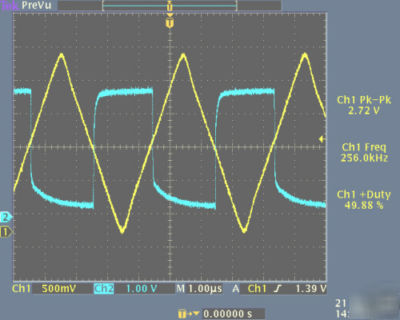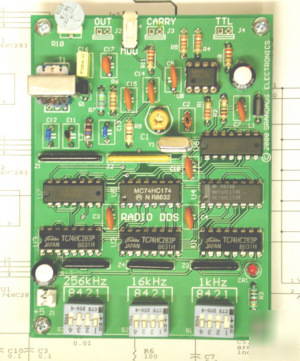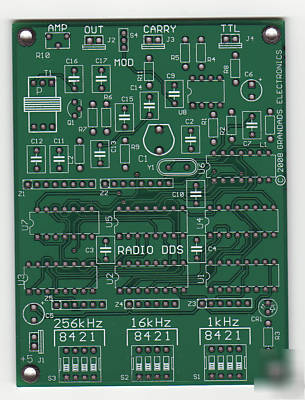Machine Recycling Discussion and Moderated Newsgroup > Separate Parts
> Electrical Parts
> North
> New
> D.i.y. 12-bit crystal based dds circuit complete kit
D.i.y. 12-bit crystal based dds circuit complete kit
This is another circuit board I did to formalize a bread-board circuit I have been using for years. I like to work on old time tube radios, some which have a non-isolated (hot) chassis, like those known as the All American Five, so I wanted a simple signal generator that ran from batteries isolating it from line power. This unit, when fully assembled, will run from either 3 or 4 AA-cells. Total power drain is about 30mA with everything running, so it is not as low power as the 100kHz calibrator, but it is fully synthesized. This board used a 12-bit discrete DDS (direct digital synthesizer) and is simple enough that you can upgrade it with your own modifications.
To be able to set the IF (intermediate frequency) of most radios, I wanted 455 kHz. This dictated at least 1 kHz resolution. To cover the old AM (Medium Wave) radio band, the output needed to go above 1610 kHz, dictating a clock of around 4 MHz (Nyquist limit is 2x maximum output). Here's where DDS (direct digital synthesis) is nice. A 12-bit DDS has a base of 4,096, so if a 4.096MHz crystal is used, then exact 1kHz can be obtained. I wanted to use only off-the-shelf parts, so rather than using a look-up table EPROM to get a sinewave output, I used a triangle wave DAC and an RS422 level shifter to give a TTL output. Since radios are narrow band, the harmonic content of the triangle waveform won't be a problem. I then added a Hartley modulation oscillator to help with tuning of AM radios, and for those who want to use higher harmonics for putting up markers, I brought out the carry pin from the phase accumulator. This pin is harmonic rich and can be used to generate markers at intervals set by frequency setting of the synthesizer. There is a filter on the triangle wave to round the DAC edges a bit, and a potentiometer to allow dialing down the amplitude.
The 4.096MHz HC-49/U crystal has enough pull range with the on-board adjustment capacitor that you can easily set the output to better than about 10ppm (this is only 10 Hz at 1 MHz output). The stability with store-bought crystals over temperature is not good enough to make this a "signal generator," but it is more stable than most analog tube radios. You can use the TTL output to source a signal to digital test circuits, but because this low resolution DDS has a lot of jitter (period of one clock time), it might not be suitable for your needs.
To set the frequency, there are three four-bit DIP switches, which allow programming the output in hexadecimal. The weighting of each bit is silk-screened onto the board, as can be seen from the photo. This is not a perfect synthesizer, and you could do a lot better by getting an Analog Devices AD9851 or similar and using a PIC microcontroller to run it. However, every part on this board can be gotten from Jameco, Mouser or Digi-Key and put together in a short time. Since all the parts are old-school leaded parts, rather than surface mount, there is plenty of room for experimenting.
The board is 3x4 inches (75mm by 100mm), with four mounting holes so you could put it into a metal cases with only the switches exposed. The kit comes with a nice covered 4-AA (LR6) battery pack with leads and a switch (batteries are not supplied). The photos show an assembled unit so you can see what it looks like, along with a view of the blank board. The schematic and parts list can be seen at: http://novatech-instr.com/Fun/Crystals/rad_dds.pdf
Thanks for looking. (Grandad's Electronics is a registered trade name of Novatech Instruments, Inc.)





